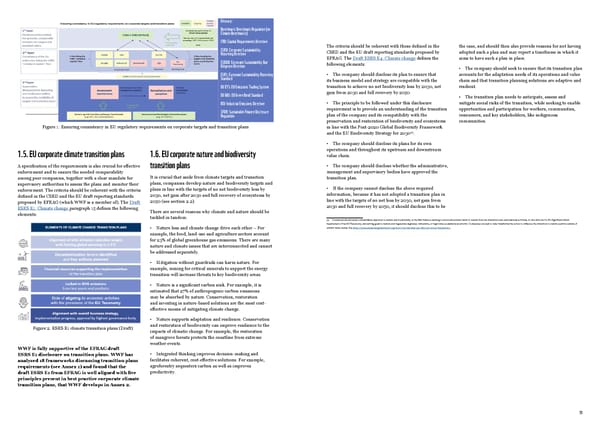11 The criteria should be coherent with those defined in the CSRD and the EU draft reporting standards proposed by EFRAG. The Draft ESRS E4: Climate change defines the following elements: • The company should disclose its plan to ensure that its business model and strategy are compatible with the transition to achieve no net biodiversity loss by 2030, net gain from 2030 and full recovery by 2050. • The principle to be followed under this disclosure requirement is to provide an understanding of the transition plan of the company and its compatibility with the preservation and restoration of biodiversity and ecosystems in line with the Post-2020 Global Biodiversity Framework and the EU Biodiversity Strategy for 2030 22 . • The company should disclose its plans for its own operations and throughout its upstream and downstream value chain. • The company should disclose whether the administrative, management and supervisory bodies have approved the transition plan. • If the company cannot disclose the above required information, because it has not adopted a transition plan in line with the targets of no net loss by 2030, net gain from 2030 and full recovery by 2050, it should disclose this to be 22 Companies should adopt a stewardship approach to nature and biodiversity, in the first instance seeking to avoid and prevent harm to nature from the transition plan and business activities, in line with the Do No Significant Harm requirement of the EU Taxonomy, and setting goals to restore and regenerate degraded, vulnerable, or high-value ecosystems as priority. Companies can seek to take transformative action to influence the transition to nature positive outside of current value chains. See https://sciencebasedtargetsnetwork.org/how-it-works/what-are-sbts/our-action-framework/. the case, and should then also provide reasons for not having adopted such a plan and may report a timeframe in which it aims to have such a plan in place. • The company should seek to ensure that its transition plan accounts for the adaptation needs of its operations and value chain and that transition planning solutions are adaptive and resilient. • The transition plan needs to anticipate, assess and mitigate social risks of the transition, while seeking to enable opportunities and participation for workers, communities, consumers, and key stakeholders, like indigenous communities. 1.5. EU corporate climate transition plans A specification of the requirements is also crucial for effective enforcement and to ensure the needed comparability among peer companies, together with a clear mandate for supervisory authorities to assess the plans and monitor their enforcement. The criteria should be coherent with the criteria defined in the CSRD and the EU draft reporting standards proposed by EFRAG (which WWF is a member of). The Draft ESRS E1: Climate change paragraph 15 defines the following elements: WWF is fully supportive of the EFRAG draft ESRS E1 disclosure on transition plans. WWF has analysed 18 frameworks discussing transition plans requirements (see Annex 1) and found that the draft ESRS E1 from EFRAG is well aligned with five principles present in best practice corporate climate transition plans, that WWF develops in Annex 2. 1.6. EU corporate nature and biodiversity transition plans It is crucial that aside from climate targets and transition plans, companies develop nature and biodiversity targets and plans in line with the targets of no net biodiversity loss by 2030, net gain after 2030 and full recovery of ecosystems by 2050 (see section 2.2). There are several reasons why climate and nature should be tackled in tandem: • Nature loss and climate change drive each other – For example, the food, land-use and agriculture sectors account for 23% of global greenhouse gas emissions. There are many nature and climate issues that are interconnected and cannot be addressed separately. • Mitigation without guardrails can harm nature. For example, mining for critical minerals to support the energy transition will increase threats to key biodiversity areas. • Nature is a significant carbon sink. For example, it is estimated that 27% of anthropogenic carbon emissions may be absorbed by nature. Conservation, restoration and investing in nature-based solutions are the most cost- effective means of mitigating climate change. • Nature supports adaptation and resilience. Conservation and restoration of biodiversity can improve resilience to the impacts of climatic change. For example, the restoration of mangrove forests protects the coastline from extreme weather events. • Integrated thinking improves decision-making and facilitates coherent, cost-effective solutions. For example, agroforestry sequesters carbon as well as improves productivity. Figure 2: ESRS E1 climate transition plans (Draft) Glossary: Benchmark: Benchmark Regulation (on Climate Benchmarks) CRD: Capital Requirements Directive CSRD: Corporate Sustainability Reporting Directive CSDDD: Corporate Sustainability Due Diligence Directive ESRS: European Sustainability Reporting Standard EU ETS: EU Emissions Trading System EU GBS: EU Green Bond Standard IED: Industrial Emissions Directive SFDR: Sustainable Finance Disclosure Regulation Figure 1: Ensuring consistency in EU regulatory requirements on corporate targets and transition plans
 Corporate Sustainability & Transition Plans Page 5 Page 7
Corporate Sustainability & Transition Plans Page 5 Page 7